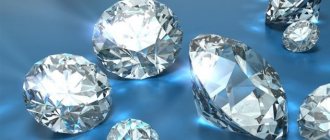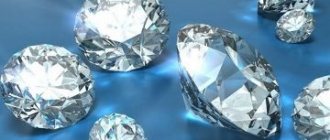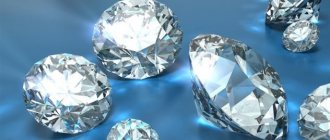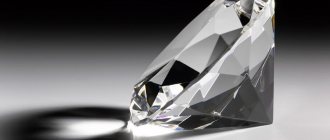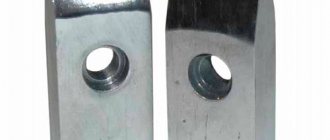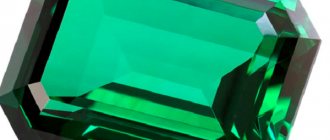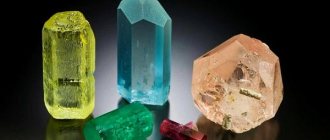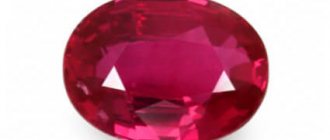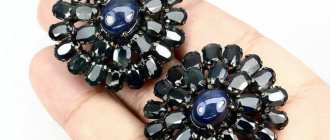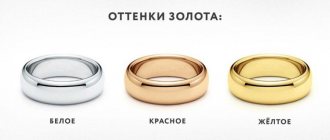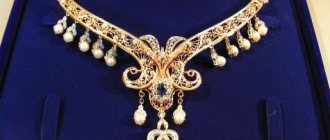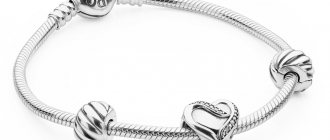Which is better: zircon or cubic zirconia
Zircon, created by nature, is comparable in beauty to precious sapphires and fits organically into any jewelry. Due to the presence of metal impurities in the structure, it has a wide range of colors. Popular varieties:
- jargons – yellow-golden;
- hyacinths - red;
- Starlites are blue.
There are natural specimens in green and black. The crystals of the mineral have a bright shine. This property is successfully used in jewelry to imitate diamonds, chrysolites, and amethysts. Transparent pale blue specimens are especially good. Green zircons contain radioactive substances, the presence of which is determined using a special device.
Synthetic cubic zirconia has become popular due to its extraordinary shine and greater hardness. These qualities bring the mineral closer to diamonds; it looks great in earrings, rings, and necklaces. An artificial gem is not inferior in characteristics to a diamond, and the cost is much lower. After the appearance of cubic zirconia, the demand for products with precious stones dropped significantly.
In choosing: zircon or cubic zirconia, the determining role is played by the appearance, the cost of the product is of great importance.
Chemical composition and physical properties
Zircon is zirconium silicate. Natural semi-precious mineral. Chemical formula: Zr[SiO4]. The stone can be colorless or have a color that depends on the presence of impurities in its composition - copper, iron, titanium, zinc. The most beautiful and valuable specimens of jewelry quality are considered to be golden-yellow stones - jargons, and rare red ones - hyacinths; blue, green and black zircons are also found.
Zircon crystals have a bright, diamond-like luster, which is why they are often used as imitation diamonds in jewelry. It is noteworthy that the bright green large minerals contain radioactive components and can be a rather dangerous source of radiation.
Natural green zircon
Cubic zirconia is zirconium dioxide - ZrO2, also called cubic zirconium. This is an artificially grown mineral. At first glance, it is hardly distinguishable from faceted zircon, but the refractive index of cubic zirconia is much higher, and its optical properties are very similar to diamond. The color of the stone can be different and depends on the additives introduced.
Properties of zircon
Zircon is a natural mineral, most often brilliant-cut, so colorless specimens are sometimes mistaken for diamonds. What they have in common with the royal stone is the bright play of reflections and the ability to refract the sun's rays. These properties of zircon are close to diamond, but the latter does not have a variety of colors. In terms of cost, starlites are equal to sapphires.
The mineral's hues are given by impurities of titanium, copper, zinc, iron, and calcium. The name is based on the Persian word “tsargun”, which means the color of gold. This is what they were called by the inhabitants of Western Asia, where the first specimens were found. The Portuguese called the gems discovered in Sri Lanka slangs, pronouncing the word in their own way.
There is a legend about the origin of red minerals. During the fight, the young man Hyacinth dies; his hardened blood turns into stones, which are called hyacinths. Starlites are much less common than other varieties, but they can be obtained by firing “tsarguns” at high temperatures.
Zircon is endowed with several magical properties: it helps to concentrate and develop your abilities. It is believed that the gem increases mental capabilities, relieves fatigue, improves vision, and brings good luck in trading. Colored specimens have different medicinal properties:
- starlits - save from depression;
- hyacinths - normalize the functioning of the digestive and excretory systems;
- yellow ones - solve problems with the endocrine gland.
The natural mineral is recommended to be used as a talisman when traveling. Some peoples use zircon for insomnia.
It is softer and less durable than cubic zirconia. The gem requires careful care to prevent cracks and chips. On the territory of the Russian Federation, zircon occurs in Yakutia and the Urals. Large volumes are mined in East Asia. There are deposits in the USA, Brazil, Canada, and Australia.
Stories of the origin of stones
Zircon is mined from igneous rocks of volcanic origin. The first samples were discovered in South-West Asia during the existence of Persia. The main stone mining sites are located in Cambodia, Vietnam, Thailand, Sri Lanka, Madagascar and Kampuchea, and small deposits are found in the following countries:
- USA;
- Canada;
- Burma;
- Australia;
- Tanzania;
- Brazil;
- Norway;
- Russian Federation.
Cubic zirconia appeared by chance. Initially, this gem was synthesized at the Lebedev Physical Institute in the Soviet Union. Thanks to the abbreviation, the open material got its name.
Cubic zirconia was grown from the natural metal zirconium using the hydrothermal method (a process of obtaining the material in a closed system at high temperature and pressure).
Scientists wanted to obtain innovative materials for laser equipment, and discovered a technology for producing artificial jewelry stone.
The FIAN hydrothermal method remains the most reliable on the planet.
For more information about cubic zirconia, watch the video review:
Origin of cubic zirconia
Cubic zircon CZ (Cubic Zircona) is another name for an artificial mineral. Scientists from the Physical Institute of the Academy of Sciences were developing materials for laser equipment. As a result of numerous experiments, transparent stones were obtained, the name of which is based on the abbreviation of the institute.
The mineral began to be used in jewelry thanks to enterprising people. Some stones left after the experiment had defects and were sold as souvenirs. Someone decided to cut such a specimen. It sparkled no worse than a diamond, and they began to sell it like a jewelry stone. The name took root only in the territory of the former USSR. In other countries this mineral is called zirconite.
The gem turned out to be convenient for cutting. The play of light in optical qualities approaches that of a diamond. With the help of metal impurities, you can obtain the color of almost any precious stone. At first, cubic zirconia was passed off as a diamond; outwardly it was difficult to identify a fake.
Through the transparent surface of cubic zirconia, you can see objects. This is a hard material, slightly inferior to a diamond - 8.5 on the Mohs scale for the first, versus 9.0 for the second. Both are capable of scratching glass.
If you run a diamond across cubic zirconia, a mark will remain. The artificial stone weighs more than a diamond.
Differences between zircon and cubic zirconia
Zirconium
If we give a specific characteristic, then:
- cubic zirconia is an artificially created stone. It is a cube of zirconium. It was originally grown in a laboratory for the purpose of being used as a substitute for a diamond. As a result, jewelers became interested in its properties, and the stone began to be used in jewelry under its real name;
- zircon and zirconium are bonded together. The first is a silicate of the second. Refers to natural elements. The stone is considered semi-precious.
The differences between cubic zirconium and natural ones can be understood if you carefully look at the stones:
- cubic zirconia has smooth contours, is transparent, and has purity;
- zircon contains voids and inclusions of particles.
Important! The weight of cubic zirconia is greater than that of zircon.
Properties
Cubic zirconia is grown by crystallization of the melt, which is constantly heated and has chemical activity.
Its properties are dense and durable, like diamond. If sunlight is passed through cubic zirconia, it will begin to shimmer and sparkle. This property is identical to that of a diamond. Therefore, it is difficult even for specialists to distinguish two stones from each other. This can be done using a magnifying glass. Cubic zirconia, after being cut, acquires rounded edges, while in a diamond they have clear contours with sharply honed edges. But you can only consider this if you remove the stone from the cut.
Cubic zirconia is difficult to process, as it begins to crumble and crack. To give the stone greater shine when exposed to sunlight, the upper part is made deep and the lower part flat.
cubic zirconia
Zirconium, also similar in appearance to diamond or diamond, has lower hardness. When processed, the edges lose their shine and no longer sparkle in the light. In terms of hardness, zircon is inferior to cubic zirconia.
External signs
To understand how zirconium differs from cubic zirconia, you should consider in detail the properties of the stones.
Zirconium
The stone has the following properties:
- In its natural form it is colorless. Depending on the presence of impurities of copper, iron, zinc, it may change color. In jewelry, golden-yellow and red stones are of particular value. Blue, green and black zircons are used. Yellow can be confused with citrine, a semi-precious stone that is a type of quartz.
- Zircon has a bright shine, similar to diamond or diamond. Therefore, it is often used as an imitation of expensive precious stones.
- Transparent or translucent. May have inclusions in the form of bubbles and cracks, scratches and clouding. They are formed during crystal growth.
- It has a pure glass luster with a bright tint. The surface may be matte or greasy.
Attention! Large-sized zirconium with a bright green color contains radioactive components. They are a source of harmful and hazardous radiation.
cubic zirconia
- Has a diamond shine.
- The surface is transparent. The newspaper font is easy to read through the stone.
- Depending on the impurities, it may have different shades.
- Used as an insert in jewelry.
If, when purchasing jewelry, you have doubts about the origin of the stone, it is better to contact a specialist.
Zircon
Origin and deposits
The difference between the stones lies in their origin. Zircon is a mineral of volcanic origin. It is mined from igneous rocks.
Stones for jewelry production are mined mainly in East Asian countries: Thailand, Sri Lanka, Vietnam, and Madagascar. Austrian and Brazilian stones are less common. In Russia, production is concentrated in Yakutia and the Urals.
Cubic zirconia was created artificially in 1970 at the Lebedev Physical Institute of the Academy of Sciences. That is why the synthesized stone acquired such a name. Today, new technologies for creating cubic zirconia have emerged. But the best specimens are obtained at this academy.
Jewelry
Zircons and cubic zirconia are used in the manufacture of jewelry.
Cubic zirconia is used in jewelry of low price value. It is used as an imitation diamond. It gained its popularity among jewelers due to its hardness and good optical properties. In addition, the crystal can be painted in any color. Jewelry with cubic zirconia looks very presentable, which is why it is popular among buyers.
Zircon is a natural stone, and it is extremely difficult to obtain a mineral of suitable size and quality. Therefore, it is not used in mass production in jewelry. Another reason is that the stone scratches easily, so the stronger cubic zirconia is used instead.
What are the differences between the stones and the difference in price?
The main difference between zircon and cubic zirconia is that the first is a natural material, and the second is artificially created. The difference between zircon and cubic zirconia is noticeable externally. Thanks to inclusions of metals, the first one comes in different shades. There are voids inside the stone. Artificial crystal is more transparent and shiny. It's harder, heavier.
Zircon is more expensive and is less commonly used in jewelry. A natural gem is usually taken as a whole crystal and framed in gold or silver, which is why the cost of jewelry with it is much higher.
Cubic zirconia, with its shine and wide range of colors, attracts craftsmen to create inexpensive products that are accessible to a wide range of buyers. Due to the qualities inherent in diamonds, artificial stone is used in metalworking, optics, radio engineering, and medicine.
Properties and uses of stones
Cubic zirconia is much stronger and harder than zircon, which is fragile. Natural minerals may become chipped and scratched if dropped. A synthetic gem shines brighter than a natural mineral due to its light refraction characteristics similar to diamond.
Due to their quality, cubic zirconias are widely used:
- in the manufacture of jewelry;
- in radio engineering;
- in the creation of optical devices;
- in the medical industry;
- in metalworking.
Zircon has become rarely used in jewelry making and has found its use in the following industries:
- production of fire-resistant materials (enamel, paint, brick);
- extraction of hafnium, uranium, zirconium from the mineral.
Jewelry made of cubic zirconia and zircon
Jewelry craftsmen are happy to use zircon of different colors as inserts in rings, earrings, and pendants. The stone goes well with other precious gems and is framed with any metals.
Transparent zircons are diamond cut, while colored zircons are cut in steps. Brown minerals after heat treatment acquire shades of blue and blue.
Jewelry with cubic zirconia is varied. It is successfully used to imitate precious gems. Jewelry looks impressive and is much cheaper than items with natural inserts. This artificial stone is highly durable and does not require special care.
The choice of jewelry insert depends on each person's personal preference. The appearance, cost, size of the mineral and quality of cut are important. Zircon and cubic zirconia are two stones that are similar in appearance but different in structure and price. Unscrupulous sellers and jewelers can pass off a synthetic gem as a natural one, so you need to carefully study the documents for the jewelry.
Which is more expensive
If we talk about cost, then cheaper is cubic zirconia, more expensive is zircon.
Natural zircon stone is quite expensive. Its price is comparable to the cost of sapphire. Jewelers use zircon as a solid crystal and use gold and silver as a setting.
Cubic zirconia, on the contrary, is inexpensive. And therefore it is more often used in inexpensive jewelry and costume jewelry. It is popular among lovers of precious items due to the fact that in most cases it looks no worse than natural stone. Therefore, it allows the buyer to save on cost rather than on quality.
Price for cubic zirconia
The price for an artificial analogue of zircon, cubic zirconia, is low, depending on the color of the stone, and does not exceed 3 US dollars per carat.
The modern jewelry market has set approximately the following prices for cubic zirconia: small ones, in a batch of 100 pieces, cost about 10-15 dollars on the wholesale markets. Their cost is significantly influenced by a number of factors.
Cubic zirconias that imitate rubies, emeralds, sapphires, and topazes are more expensive. This is due to the fact that green and blue colors are more difficult to synthesize. As a result, their prices are 2-3 times higher.
Based on the size, the cost of cubic zirconia varies. All artificial zircons up to 3 carats generally have a standard price. Bulkier, heavier cubic zirconias are usually more expensive. Their cost directly depends on the manufacturer, as well as on specific additives when stabilizing the artificial mineral.
The price of cubic zirconia is also influenced by the cutting methods used for it. However, it is installed on a specific product by a jeweler. Taking into account the fact that the stone is quite simple to process, it is given all sorts of shapes, including traditional diamond ones. Those shaped like drops, hearts, or pentagonal polygons are rated higher.
The manufacturing company also matters when setting the cost of cubic zirconia. Thus, the Swarovski company, a world-famous manufacturer of artificial crystals, sells its stones at higher prices than those produced in China and Thailand.
Based on the above, it follows: when answering the question of what is more expensive - zirconium or cubic zirconia, we must remember that the latter has nothing to do with precious and native stones, unlike zircon (zirconium). It is a fairly simple artificial creation with low production costs.
Historical reference
Pure zirconium, free from impurities, was isolated only in 1925.
To date, the exact origin of the word “zircon” has not been established. Some researchers believe that it has its origins in the Arabic zarkun, meaning cinnabar, or comes from the Persian zargun (golden).
The largest deposits of minerals containing zirconium are located in India, Australia, Brazil, and the USA. The expanses of Russia are also rich in this metal; the country accounts for almost 10% of its world reserves. Thus, geologists have established that ores with zirconium are available in almost unlimited quantities on the Kola Peninsula, in the magmatic outcrops of the Khibiny massif.
There are a lot of compounds that contain zirconium in nature. However, it is found only in association with oxygen, as oxides or silicates. The main mineral in which it is present is native and gemstone zircon.
What do they look like?
The appearance of cubic zirconia resembles a diamond due to identical refractive and dispersion properties. Another name is cubic zirconia. This synthetic mineral is obtained in the laboratory for further use in lasers. Later, jewelers paid attention to it. The hardness of the mineral is close to diamond and much harder than natural zirconium. By adding metal oxides during the production process, stones of different colors and shades are obtained: chromium oxide turns green, making it look like an emerald, and erbium oxide turns red, similar to ruby or garnet. Zircon and zirconium are both names used to denote a mineral of volcanic origin, rarely found in nature in a palette of colorless to blue-black shades. After heat treatment it acquires beautiful colors. The peculiarity of the mineral is internal inclusions and voids.
Artificial cubic zirconia stone
Cubic zirconia is an artificial material, zirconium dioxide. It has a crystalline cubic lattice. The main application is jewelry, where it acts as a simulator of precious stones. Rings and earrings with cubic zirconia are especially popular.
Cubic zirconia, zirconium dioxide, is an unstable chemical element in its chemical and physical properties. Its stabilization is achieved through the addition of yttrium, calcium, and manganese oxides.
Cubic zirconia has a high refractive index of light, close to that of diamond. As a result, non-specialists cannot always distinguish it from this expensive stone.
Cubic zirconia is obtained chemically, through industrial crystallization. Initially, this mineral is colorless, to which color shades are added by the inclusion of transition and rare earth elements.
Thus, the addition of cerium gives orange, yellow and red colors. Chrome colors cubic zirconia green, neodymium purple. Titanium metal provides the crystal with a golden-brown hue, and irbite gives it a pink color.
Zirconium - Zr
Another one? Yes! This time it is a silvery metal number 40 in the periodic table. It is used in nuclear energy due to its high melting point of 1850 degrees and resistance to corrosion. And also for the production of fireworks and the creation of ceramic dentures in dentistry.
What does jewelry have to do with it? It's simple! For those who studied chemistry well. Zirconium oxide exists in three forms, one of which is crystalline. High refractive indexes and light scattering gave impetus to the creation of cubic zirconia (see above). To create a cubic zirconia crystal, zirconium oxide powder is heated and vanadium, chromium or other elements are added for color. We hope that after this the question of what is the difference between zirconium and cubic zirconia will disappear forever.
Zirconium is a metal
Zirconium is a chemical element on the periodic table with atomic number 40. It is a simple substance, a metal, and the color is silver-gray. Among its main characteristics are high ductility and corrosion resistance. Zirconium does not exist in nature in its pure form. It was first obtained as dioxide only in 1789 due to chemical transformations of zircon, which is a natural zirconium silicate.
Zircon prices
Not everyone can afford this gem. Its cost is directly dependent on the color of the stone. Modern jewelers use mainly brown, red, green and blue minerals. In terms of cost, those with blue colors come first. Next in descending order are red and green. The cost of stones with brown tints is much lower. With other colors it’s even cheaper.
Currently, prices on the market are approximately the following: blue zircon costs from 170 to 400 US dollars per carat (a generally accepted unit of mass, equal to 200 mg - 0.2 g). The cost of green and red minerals ranges from $150 to $250. Brown zircons cost between $100 and $150 per carat. Prices for zirconium of other colors are 5-15% lower than those with brown shades.
During the Middle Ages, zircons with red-brown and bright red hues, also called hyacinths, were considered very popular gemstones. They were valued a little less than pearls. However, at present, interest in them has dropped significantly. Hyacinths are mainly in demand among people who are interested in paranormal phenomena and are interested in esotericism.
